Guidelines for Schools
School guidelines must explicitly recognize that COVID-19 is an AIRBORNE virus and communicate proper precautions to the different stakeholders (including teachers, staff, parents and children). It is spread by inhaling AEROSOLS containing viral particles, which are exhaled by others. Keeping hands and high-touch surfaces clean is basic hygiene for all situations, but excessive use of disinfectants may be harmful, and do little to contain the spread of COVID-19 without airborne precautions in place as well.
Policy guidelines must also be adjusted as new variants occur. Preventing infection became significantly more difficult with the Delta variant due to high transmission (2-2.5X original variant and 1000X higher viral load) and further difficult with the Omicron variants (BA.1 and BA.2), the reduction in vaccine efficacy for transmission and severe disease, and the consequences of infection are worse due to higher severity, especially for children (including Multisystem Inflammatory Syndrome, MIS-C/PIMS-TS). The Omicron variant proved to be even more rapidly transmissible likely due to a change in the mechanism of infection that results in smaller viral loads that can infect, as well as bypassing much of the immunity due to vaccination and prior infection. Multiple infections are possible both of different variants and, especially for Omicron, by a single variant.
The role of children and youths in the spread of the coronavirus has been hotly debated since the first infections were registered. One thing is clear, children and youths can infect others. It is also clear that infected children and youths often show few or no signs of being ill. And it is just as clear that children and youths can also suffer lasting organ damage as the result of a COVID-19 infection. This doesn’t automatically mean that all children and youths are potential “superspreaders,” driving infection rates around them. Still, children and youths — through school, friends and sports — often have far more social interaction than adults. Like adults, young people often ignore social distancing and hygiene rules if they do not have clear guidelines in place to do otherwise. These guidelines are recommended to minimize risks in school settings.
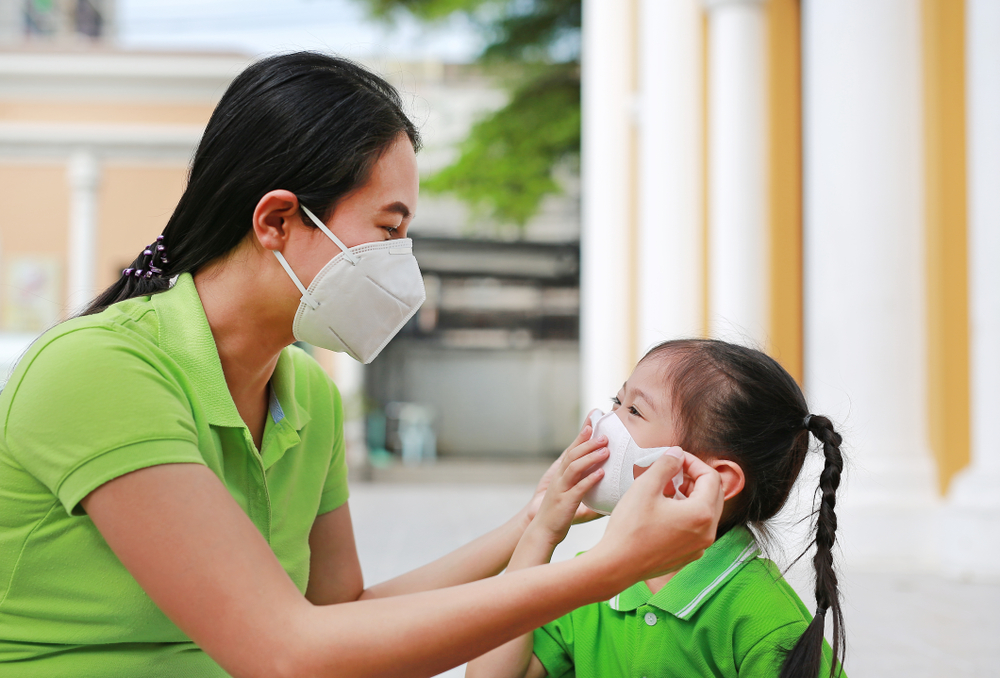
Community Transmission
- The best way to ensure safety of children, teachers and families is to reduce transmission in the community.
Remote Options
- Remote options provide a means for families to make decisions about the risk they wish to take for their children, and themselves.
- Families whose children are clinically vulnerable, or have family members who are clinically vulnerable should consider the risk and consequences of infection in deciding about remote options.
- Where remote options are chosen, children may be organized to engage in outdoor activities with other children so as to provide social contact. Look for special games and other activities that allow for social distancing (due to Delta and Omicron, significantly larger distances are necessary).
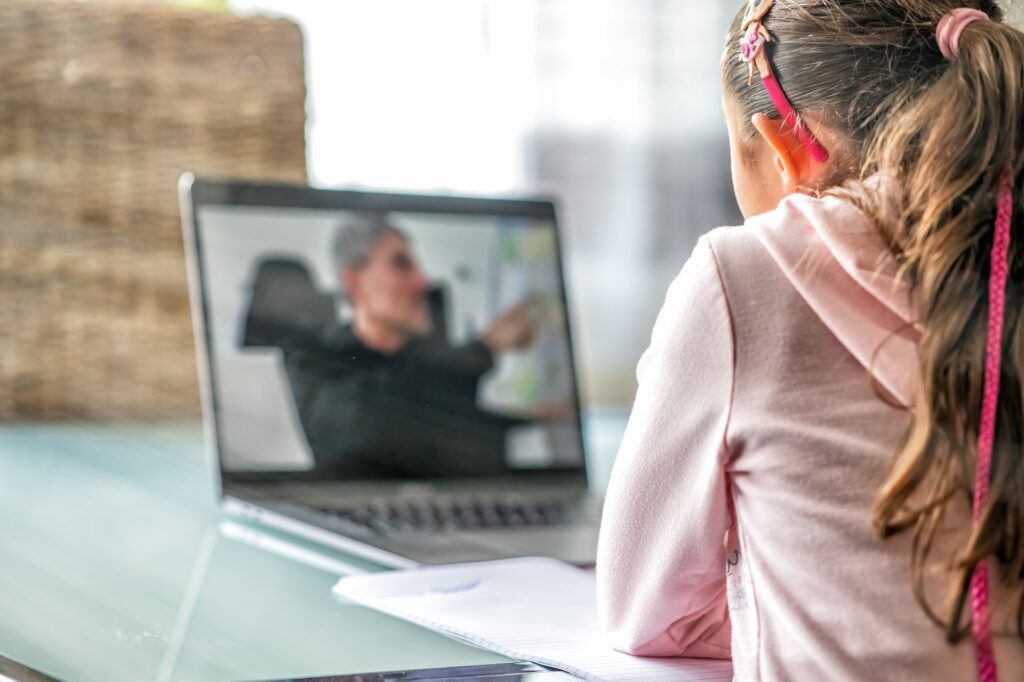
Ventilation (General Guidelines [1])
- Outdoor spaces should be used for teaching and learning, and especially for activities where masks are not possible such as for lunch, and for sports and choir where high viral loads are generated. Use canopies where needed but avoid closed-sided tents as these are no different from being indoors. Where this is not possible, actions for indoor activities should be accompanied by significant effort to reduce the risk of transmission.
- Mechanical ventilation (HVAC) systems should not allow recirculation without proper air filtration.
- CO2 Monitors can serve as indicators of sufficient ventilation levels or indoor air quality risk: Use C02 meters, mounted on a wall approximately 5’ (1.5 m) up, not near a window, to measure the level of exhaled breath. Below 600 ppm is ideal; above 700-800 ppm the risk of transmitting COVID increases rapidly. With good air filtration (by central ventilation systems and HEPA air purifiers), the C02 target is less than 1000. Use C02 measurement to guide the following measures to improve indoor air quality.
- Require the use of MERV 13 filters or equivalent (or higher efficiency filters) in all HVAC systems. If the system cannot function with MERV 13 filters, use the highest MERV filter grade that the system will tolerate and/or use a combination of filters and air cleaners (see next section) that achieve desired levels of air filtering.
- Windows and doors should be open to allow fresh air in, both while the room is in use and afterwards for long enough for sufficient air exchange. Please note that, while opening windows may help reduce indoor risks by dilution of airborne particles, effectiveness varies greatly with wind speed and direction, temperature, building orientation, etc. While it reduces viral concentration in the air, opening windows alone may not be enough to keep C02 levels in the safe range because the intermittent amount of air exchanged with the outdoors. Avoid opening windows at desk level. Window fans should pull air out of the room. Ceiling fans should be on “winter” setting to draw air upwards.
- Open windows should be considered as a temporary mitigation measure and shouldn’t be used as a robust or permanent solution to air filtering precautions for indoor space.
- Students and staff should wear outdoor clothing in colder weather to allow windows to be kept open to the maximum extent possible.
- Do not use rooms that lack external windows, suitable ventilation or air cleaning systems.
Filtration and Air Cleaners (High Efficiency Filters)
- Use of HEPA filters is encouraged in all shared indoor spaces, it cleans the air reducing the density of virus carrying particles in the air, preventing infection of those who are not infected.[2]
- When properly installed, ultraviolet germicidal light (UVGI) can be used as supplementary treatment to ventilation and air filters.
- Devices that spray chemicals into the air and electronic air cleaners (ions, plasmas, hydroxyls, photocatalysis) can be harmful and should be avoided.
- To maximize filtration while simplifying installation, choose a portable air cleaner that has a clean air delivery rate (CADR) that is large enough for the size of the room or area in which you will use it. The higher the CADR, the more particles the air cleaner can filter and the larger the area it can serve. Most air cleaner packaging will tell you the largest size area or room it should be used in. Portable air cleaners often achieve a high CADR by using a high-efficiency particulate air (HEPA) filter.
- The reduction in virus carrying airborne particles improves with increased level of filtering. EPA HEPA filtering guidelines for environmental pollution are 5 ACH [3] (roughly one standard HEPA filter per classroom equivalent to 300-500 CADR). Unlike COVID infection, environmental pollution harm occurs by mass action, while even very small amounts of viral particles can cause infections [4], thus greater reductions should be the objective. COVID specific guidelines should be at least 10 to 12 ACH [5] (roughly 2 standard HEPA filters or 600 to 800 CADR per typical 25’ x 32’ classroom). The optimal air filtering system would ensure that exhaled air is filtered before another person breathes it in. Understanding the flow of air in the room is necessary to optimize filtering.
- Reduction by 65% of airborne particles was obtained in a simulated environment in which 2 HEPA filters were located near an infected individual at 5 ACH total [6]. This shows the benefit of air filtering but also indicates higher levels of filtering should be used.
- The placement of filters near the source is significantly better than other placements that resulted in 50-55% reduction of particles.
- This optimized placement of filters cannot be achieved in a classroom since any child or the teacher might be infected. Without knowing which child is infected, the filters cannot be placed around that child or teacher. Movement around the classroom also results in exposure variation.
- This points to the need for higher ACH levels than EPA guidelines.
- Even higher ACH is necessary for Delta and Omicron variant due to higher viral load of exhaled air particles and ease of infection by small amounts of viral particles.
- Properly designed DIY Air Cleaners have proven to be highly effective and less costly and can be considered as effective measures. The units should be placed near the center of the room, where the air will not flow directly over anyone, elevated to avoid tripping hazards, and run on the highest setting. High performance filters (MERV-13 or better) should be changed when needed to maintain performance and capacity.
- Schools should use air filters not just in classrooms but also in other shared spaces including lunchrooms, hallways, bathrooms, locker rooms, gyms, lounges, and offices (see below), with a maximum sound level of 40-50 decibels, especially in classrooms.
Masks
- Everyone should wear masks in indoor spaces. Outdoors masks should be worn where sufficient distance between individuals is not possible.
- Indoors closer than 3 ft should be considered VERY CLOSE CONTACT.
- The space of an entire connected air enclosure, during and several hours after occupancy by an infected individual, should be considered CLOSE CONTACT as airborne respiratory particles expand to fill the room and persist in the space until ventilation removes them.
- Outdoors, the important measure is rate and the direction of air flow—being downwind of a person who is infected can lead to infection.
- There is no single measure of adequate outdoor distance, 2 meters should be considered minimal but is not sufficient with Delta and Omicron due to the much larger viral load and small amount of viral particles that can infect.
- The quality of a mask should be that of a N95 or similar (FFP2, KF94, KN95) Double masking with a surgical and a cloth mask is an alternative. Cloth masks alone are not sufficient with Delta and Omicron.
- Masks should be evaluated for goodness of fit checking that airflow goes through the mask and doesn’t go around the mask when breathing in and out.
- Children’s masks are not as readily available as adult masks but can be obtained, especially in FFP2, KF94, KN95 versions. Masks in special sizes for children are available.
- Elastomeric half masks provide better fits and are reusable.
- High quality masks should be provided to those who cannot afford them.
- Where a student has difficulties e.g. anxiety or breathing difficulties, it would be safer for them to sit further away near an open window with air flowing outwards.
- Lists of children’s masks:
- Kids Mask Data Summary https://tinyurl.com/st6hz5xa
- Aaron J Prussin and Lindsey C Marr, Virginia Tech, https://tinyurl.com/etwcs4ae
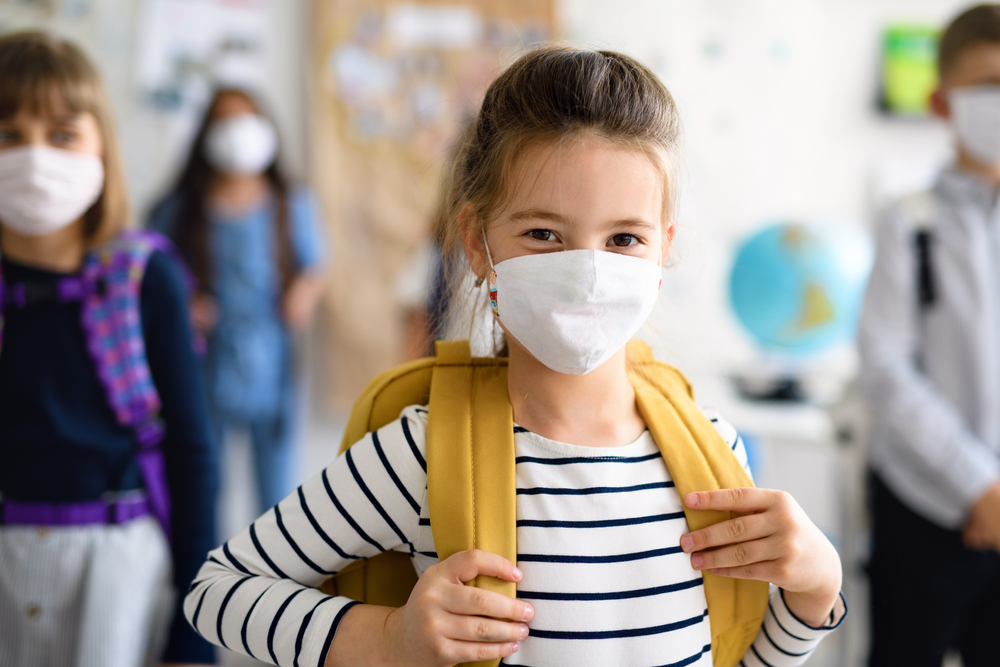
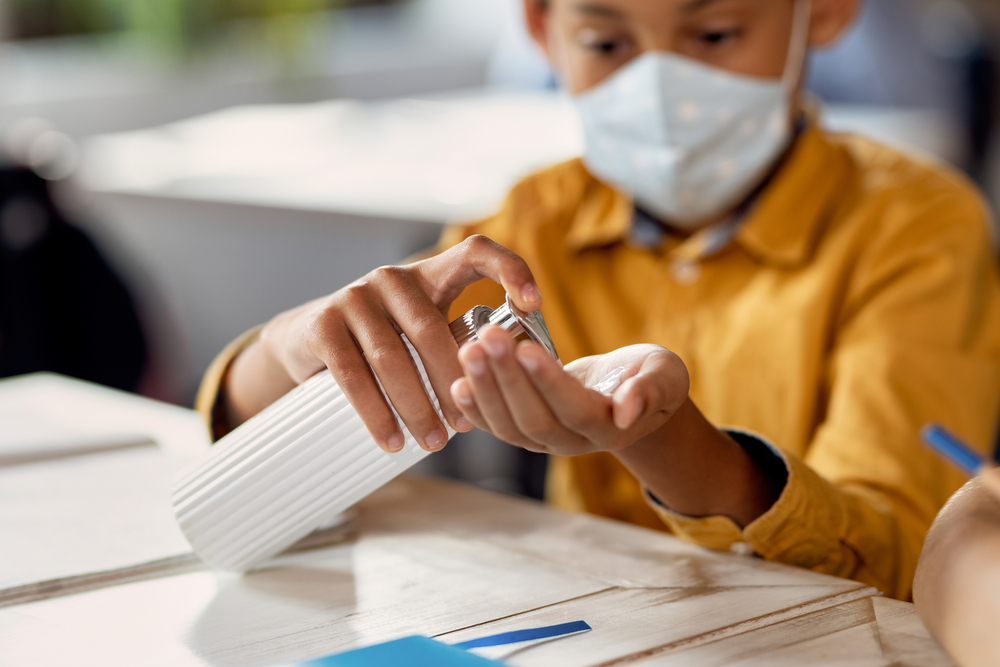
Special Spaces
- Lunchrooms
- Indoor lunches should be avoided as they lead to much higher opportunities for viral transmission including superspreader events. Where indoor lunches are necessary
- Lunch should be distributed among different spaces including classrooms, gyms, auditoriums, as well as lunchrooms for minimal density of individuals in those spaces.
- Groups in the same space should be consistent from day to day and constitute bubbles of class sizes or smaller than class sizes.
- Those who eat lunch together should be considered to be close contacts.
- Minimal time should be allocated for lunch.
- Very high ventilation standards should be used where cafeterias must be used, with ideally no recirculation (100% fresh air intake) augmented by high efficiency filtration (see sections 3 and 4).
- Bathrooms
- Bathrooms represent a high level of risk of transmission due to (a) short time high traffic use and persistent viral particles in the air leading to exposure from one individual to multiple others (from different bubbles), (b) flushing causing particles to become airborne that contain virus, (c) often poor standard ventilation.
- Dramatically improve ventilation and air filtering for bathrooms and the ventilation system should be exhausting air (negative pressure of more than 50 Pa) to avoid any cross-contamination with adjacent spaces.
- Avoid opening bathroom windows where those windows might lead to airborne particles entering other rooms through adjacent windows.
- Ensure seat covers are present and post notices to close them before flushing.
- Restrict the number of individuals in the bathroom at any time, e.g. one per every two stalls, where possible.
- Deploy multiple HEPA filters in bathrooms. Since the walls of stalls restrict air flow, it is best to have one HEPA filter per stall, even if the filter chosen has reduced air flow capacity per unit.
- Where possible position HEPA filters so that the outward airflow is toward the location of faces when seated or standing.
- Hallways: Place HEPA filters at regular intervals along hallways according to the ACH needs.
- Locker rooms and locker areas of hallways: Restrict distances between individuals to avoid interactions among different bubbles.
- Teacher lounge: Repurpose teachers lounges so that teacher to teacher transmission does not link different bubbles.
- Stairways: As much as possible, use the stair pressurization system approach using a supply fan to blow outside air into stairway or stairwell, creating a positive pressure differential across the enclosure boundary and avoiding any accumulation of contaminant or cross-contamination between adjacent spaces. The design of these ventilation systems can depend greatly on the local codes and standards, and if positive pressure is not possible, high level of ventilation (6+ ACH) or high efficiency filtration should be maintained.
- Elevators: Elevators should not be used unless absolutely necessary (e.g. for wheelchair access), and where necessary solutions for air filtration in the elevator should be installed.
- Sports: Sports should be conducted outdoors due to rapid breathing causing large amounts of respiratory particle generation.
- Gyms: Should be repurposed to permit lower density activities in other spaces, including for lunch.
- Choir: Choir should be conducted outdoors due to large amounts of respiratory particle generation.
- Offices: Offices should follow ventilation and air purification guidelines. Remote work should be done as much as possible, virtual meetings should be standardized. In person meetings should take place outdoors, in larger spac
- Schoolbuses: Masks must be worn on schoolbuses, the ventilation system should be set at 100% fresh air (no recirculation) and windows should be opened enough to let air in without compromising safety.es, and only as a last resort in offices.
- General notes for all special spaces: When necessary to flush stale air from spaces between occupied periods, operate systems for a time required to achieve at least 6 air changes of equivalent clean air supply before and after occupation.
Bubbles / Cohorts and Lower Density Schools
- In order to limit the number of close contacts and prevent wider outbreaks, bubbles should be formed that restrict within-room contact to as few individuals as possible.
- Subdivide classes by using partially remote options.
- Reduce density by expanding the space available to a class.
- Identify and utilize opportunities to expand a school’s space to additional buildings to enable lower density classrooms and smaller bubbles.
- The need for maintaining separation between bubbles should inform scheduling of bubbles for non-classroom activities, including entry to the school through the corridors, lunches, sports, and other activities.
- When an individual who is a member of a bubble becomes infected, all members of their bubble should be quarantined.
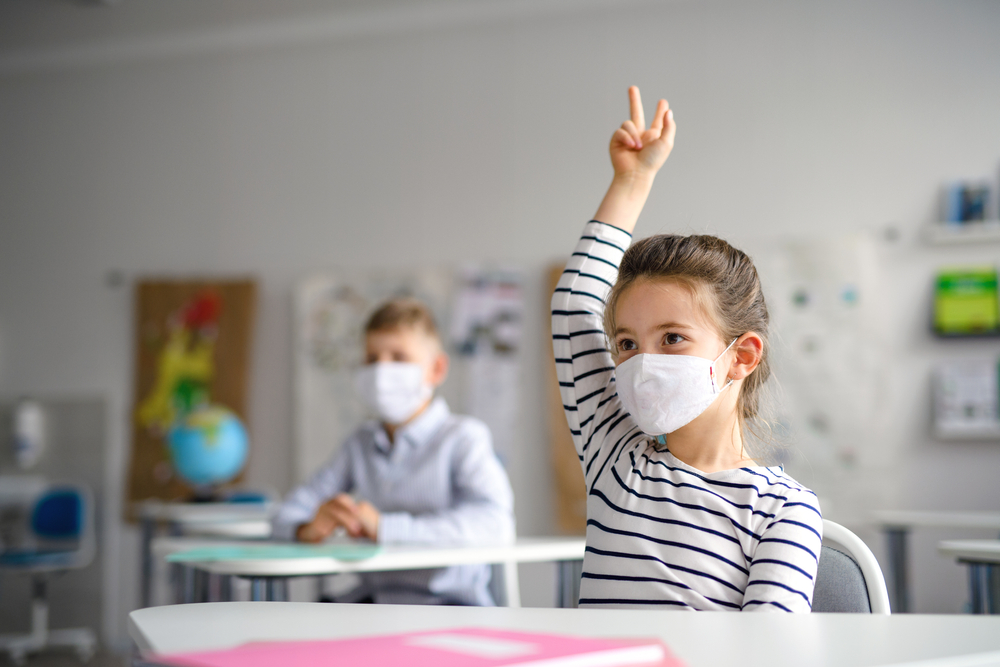
Screening Testing
- Screening testing provides for early detection and reduces transmission.
- Using PCR tests reduces the number of cases by an estimated 70-85%. Rapid antigen tests reduce the number of cases by an estimated 50% (70% sensitivity relative to PCR).[1][2][3][4]
- The rate of testing has been about 2 per week, but should be increased to every other day or even daily for the Delta variants, especially if rapid antigen tests are being used, but also where PCR or LAMP tests are being used, due to their false negative rates.
Test and Isolate
- Individuals reporting a wide range of symptoms should be tested and isolated while they wait for results.
- Isolation at home is a high risk and should be avoided if at all possible, separate quarters should be identified where individual or community resources enable out of home quarantine, as the likelihood of transmission to housemates is high.
- Where isolation at home is necessary follow guidelines for isolation at home, including separate rooms, ventilation, hepa filtration, mask wearing, avoiding shared spaces, special precautions for bathrooms, cleaning and disinfecting.
Trace and Quarantine
- Close contacts of an individual who is infected include anyone who has been in an indoor space at the same time, or within a few hours of an infected individual being present. This includes siblings and other family members and housemates. Duration of contact with an individual can be any time due to the high viral load of Delta variant [Previous guidelines of 15 min contact become less than 1 second for 1000X viral loads of Delta].
- Close contacts should be quarantined. The same protocols for isolation should be followed for someone in quarantine with the exception that multiple individuals who are being quarantined must be separated from each other (note where an individual requires special care such as a child, elderly or for other reasons, special considerations must be made for care during quarantine while limiting exposure to the extent possible).
- Testing of quarantined individuals is important for determining the need for contact tracing of their contacts. Testing negative does not remove the need for quarantine due to the incubation period lasting as long as 14 days or beyond.
- Guidelines that have been suggested to allow reduction to 10 or 7 days when accompanied by negative tests [7] assumed 100% reliable PCR tests, but their false negative rates, estimated to be 15-30%, imply 14 day quarantines are necessary.
Vaccination
- Vaccines reduce the likelihood of infection and of severe disease (by 2X and, for those infected by 2.5-3X, respectively). This protection is reduced for higher exposure due to changes in behavior or changes in policy. While vaccinated individuals are 2X less likely to be infected, they transmit at about the same rate due to similar viral load and therefore contribute to infections of others. Therefore, vaccinated individuals should follow the same rules as those of unvaccinated individuals. [Note, those who wear seatbelts or use airbags are not allowed higher speed limits or the right to drink and drive.]
Notes on Delta Variant
The Delta variant changed the properties of the pandemic, here is a summary:
- 1000X viral load [8] and equivalent density of viral particles in the air means that a person produces a large amount of airborne particles as they breathe, speak, shout and sing.
- Short time to symptoms reduced on average from 6 to 4 days, and short time to infectiousness reduced on average from 3 to 2 days.[8] Note that the incubation period continues to mean that the onset of infectiousness is not necessarily the typical or average onset but can be 14 days later.
The Delta variant also reduces vaccine efficacy against transmission and severe disease, with the transmission protection being about 2X, and the protection against severe disease being approximately 2-3X [9]. This means that for a particular exposure over a certain period of time the likelihood of severe disease is reduced by 4-6X. However, increased exposure or continued exposure increases the probability of infection so taking risks that leads to infection means that one gains only the reduction of severe disease which is 2-3X.
Combining the reduction in severity due to vaccination with the increase in severity due to Delta variant means that there is almost no change in severity for someone who is vaccinated compared to someone who was not vaccinated against the original variant.
For children, Delta is even more severe, with an increase of death rate estimated at 6-8X compared to previous variants.[4] Current estimates are 1 in 10,000 case deaths, 1 in 100 hospitalizations, and 1 in 10 long COVID (with organ damage and loss of IQ expected to be higher as it occurs even for those who do not report long COVID symptoms).
Notes on Omicron Variant
The Omicron variant is much faster transmitting. The current understanding of the reasons for the rapid transmission include an underlying physiological change in the mechanism of transmission due to a different binding mechanism that makes infection possible higher in the lungs and therefore possible with smaller amounts of viral particles, and the ability of Omicron to bypass prior immunity due to either vaccination or previous infection.
Notes on Current CDC Guidelines
- CDC guidelines continue to emphasize droplet transmission even though it has been demonstrated that COVID is primarily transmitted by airborne particles.
- Example: 6 ft is not enough in indoor spaces. https://www.cdc.gov/coronavirus/2019-ncov/prevent-getting-sick/prevention.html#stay6ft%20
- CDC guidelines continue to assume vaccination prevents transmission even though it only reduces it by a factor of about 2 for Delta, with rapid waning over several months.
- CDC is making public health a personal issue, where individual risk is being emphasized rather than public health. It also emphasizes single event risk and not the accumulation of risk over time. This is a failed public health messaging strategy that leads to harm for everyone,
- Example: Drinking while driving is not allowed due to public health implications.
- Example: Risk for vaccination of being infected and transmitting leads to others becoming infected.
https://covidactiongroup.net/proposed-ventilation-requirements-for-public-indoor-spaces
Ventilation or HEPA filtering of air near an infected individual during the very early stages of the infection may also reduce rebreathing of viral particles, reducing the viral load in their lung and potentially reducing the severity of the disease https://www.endcoronavirus.org/papers/respiratory-health-for-better-covid-19-outcomes.
EPA air pollution guidelines https://www.epa.gov/sites/default/files/2018-07/documents/guide_to_air_cleaners_in_the_home_2nd_edition.pdf
Infectious dose is unknown but is very small, at the level at which individual particles matter.https://www.cambridge.org/core/journals/epidemiology-and-infection/article/review-of-infective-dose-routes-of-transmission-and-outcome-of-covid19-caused-by-the-sarscov2-comparison-with-other-respiratory-viruses/8607769D2983FE35F15CCC328AB8289D
Dinnes et al, Rapid, point‐of‐care antigen and molecular‐based tests for diagnosis of SARS‐CoV‐2 infection, https://www.cochranelibrary.com/cdsr/doi/10.1002/14651858.CD013705.pub2/full
Khandker et al, Diagnostic Accuracy of Rapid Antigen Test Kits for Detecting SARS-CoV-2: A Systematic Review and Meta-Analysis of 17,171 Suspected COVID-19 Patients J. Clin. Med. 2021, 10(16), 3493; https://doi.org/10.3390/jcm10163493
Steven Woloshin, Neeraj Patel, Aaron S. Kesselheim, N Engl J Med 2020; 383:e38, DOI: 10.1056/NEJMp2015897 August 6, 2020, https://www.nejm.org/doi/full/10.1056/NEJMp2015897
Kucirka, L.M.; Lauer, S.A.; Laeyendecker, O.; Boon, D.; Lessler, J. Variation in false-negative rate of reverse transcriptase polymerase chain reaction–based SARS-CoV-2 tests by time since exposure. Ann. Intern. Med.2020, 173, 262–267

